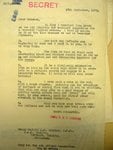The following was posted on another board in a thread on the use of 100 octane fuel during the Battle of Britain.
The following Spitfire and Hurricane squadrons are known to have used 100 octane fuel before or during the BoB:
1, 17, 19, 41, 43, 54, 56, 64, 65, 66, 72, 73, 74, 79, 85, 87, 92, 141, 145, 151, 152, 222, 229, 234, 245, 249, 264, 303, 602, 603, 605, 609, 610, 611, 616
These squadrons were stationed at the following airfields (bold text) at sometime during the BoB.
11 Group
RAF Biggin Hill
- RAF West Malling
RAF Debden
- RAF Martlesham Heath
RAF Hornchurch
- RAF Hawkinge
- RAF Gravesend
- RAF Manston, night fighter base
- RAF Rochford
RAF Kenley
- RAF Croydon
RAF Northolt
RAF North Weald
- RAF Martlesham
- RAF Stapleford
RAF Tangmere
- RAF West Malling
- RAF Ford
- RAF Lee on Solent, RN airfield
- RAF Gosport, RN airfield
- RAF Thorney Island
- RAF Westhampnett
Not sure which Sector airfield these were assigned to but as all the sector airfields had 100 octane fuel, these to would need a stock of 100 octane fuel.
RAF Detling
RAF Eastchurch
RAF Hendon
RAF Lympne
In 10 Group, 5 of the 6 airfields had stocks of 100 octane fuel.
In 12 Group, 7 of the 8 airfields had stocks of 100 octane fuel.
In 13 Group, 7 of the 10 airfields had stocks of 100 octane fuel. Of the 3 that possible didn't have stocks of 100 octane fuel, one was based in the Shetland Is. and the other in the Orkney Is.
Despite what the doubters say, I would say 100 octane fuel was in widespread use by Fighter Command if all those airfields had stocks of 100 octane fuel on hand during the battle.
The following Spitfire and Hurricane squadrons are known to have used 100 octane fuel before or during the BoB:
1, 17, 19, 41, 43, 54, 56, 64, 65, 66, 72, 73, 74, 79, 85, 87, 92, 141, 145, 151, 152, 222, 229, 234, 245, 249, 264, 303, 602, 603, 605, 609, 610, 611, 616
These squadrons were stationed at the following airfields (bold text) at sometime during the BoB.
11 Group
RAF Biggin Hill
- RAF West Malling
RAF Debden
- RAF Martlesham Heath
RAF Hornchurch
- RAF Hawkinge
- RAF Gravesend
- RAF Manston, night fighter base
- RAF Rochford
RAF Kenley
- RAF Croydon
RAF Northolt
RAF North Weald
- RAF Martlesham
- RAF Stapleford
RAF Tangmere
- RAF West Malling
- RAF Ford
- RAF Lee on Solent, RN airfield
- RAF Gosport, RN airfield
- RAF Thorney Island
- RAF Westhampnett
Not sure which Sector airfield these were assigned to but as all the sector airfields had 100 octane fuel, these to would need a stock of 100 octane fuel.
RAF Detling
RAF Eastchurch
RAF Hendon
RAF Lympne
In 10 Group, 5 of the 6 airfields had stocks of 100 octane fuel.
In 12 Group, 7 of the 8 airfields had stocks of 100 octane fuel.
In 13 Group, 7 of the 10 airfields had stocks of 100 octane fuel. Of the 3 that possible didn't have stocks of 100 octane fuel, one was based in the Shetland Is. and the other in the Orkney Is.
Despite what the doubters say, I would say 100 octane fuel was in widespread use by Fighter Command if all those airfields had stocks of 100 octane fuel on hand during the battle.

